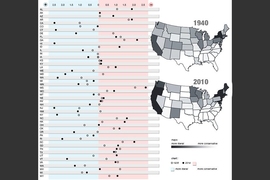Since the 1980s, the United States has often been a world leader in supporting renewable energy technologies at the state and federal level. Thirty-seven states have enacted binding or voluntary renewable portfolio standards (RPS) requiring that a portion of the electricity mix come from renewable sources by a given date. But since 2011, adoption of such standards has slowed, and in the past several years there have been many attempts — some of them successful — to weaken, freeze, or repeal renewable energy laws.
Given the outcome of the 2016 presidential election, increased federal investment in renewable energy is unlikely for the foreseeable future. As a result, state-level renewable energy policies will likely be central to driving new deployment. Past research has shown that public opinion plays a crucial role in facilitating a political consensus around new policies in U.S. states. If that’s true for renewable energy policies, then people’s views may have a major influence on future actions taken by their states.
For the past three years, MIT Associate Professor Christopher Warshaw of the Department of Political Science and Leah Stokes SM ’15, PhD ’15, now an assistant professor of political science at the University of California at Santa Barbara, have been examining the interaction between public opinion and renewable energy policymaking. First, is there evidence that public opinion and energy policy align within a particular state? And second, what determines that public opinion? For example, can the design of a given RPS policy or how it’s presented to the public — that is, how it’s portrayed or framed — increase or decrease support for the policy?
Now, an analysis by Warshaw and Stokes finds that state legislators are, in fact, broadly responsive to public opinion in this policy arena. And based on data from a public opinion survey, the researchers offer practical advice on how to bolster public support for renewable policies. Their findings are published today in the journal Nature Energy.
Public opinion and renewable energy policy, state by state
To begin investigating their questions, Warshaw and Stokes turned to data gathered by the Cooperative Congressional Election Study, a major survey supported by 56 universities, including MIT, that has its origins in a survey first funded by the MIT Energy Initiative a decade ago. In the 2014 cooperative survey, 56,200 people were asked whether they supported an RPS policy that “requires the use of a minimum amount of renewable fuels (wind, solar, and hydroelectric) in the generation of electricity, even if electricity prices increase a little.”
Using the 2014 survey data, Warshaw and Stokes explored the relationship between public opinion and policy on a state-by-state basis. Their analysis showed that in most states a majority of the public supports renewable energy requirements — although frequently by a narrow margin. In addition, public support within each state is strongly correlated with the RPS policy now in effect. Thirty-seven states plus the District of Columbia have RPS policies that are congruent with the views of a majority of their citizens, leaving only 13 that don’t. All 13 states where more than 60 percent of the public supports an RPS have a binding RPS policy, with varying levels of ambitiousness. As public support drops close to or below 50 percent, states are much less likely to have a binding RPS.
“Overall, these findings suggest that state legislators are broadly responsive to public opinion on this issue,” says Warshaw. “If public support for renewable energy policies increased, we could expect to see more renewable energy laws.”
A new experiment
In other areas of policymaking, research has shown that exactly how a policy is designed and presented can significantly impact whether the public supports or opposes it. Thus, it’s possible that certain details of RPS policies could be swaying public opinion. “We needed to gauge how the design and framing of renewable energy policies may affect people’s support for them across the states,” says Warshaw. He and Stokes set out to design a survey experiment that would give them insight into what drives people’s opinions of renewable energy policies.
They knew many factors could influence support for an RPS policy — from possible changes in electric bills to impacts on employment opportunities. A simple survey experiment might involve randomizing one such attribute at a time. For example, one group could be told that the new policy will increase residential electric bills, and the group’s response could then be compared to that of a control group that receives no information about added costs.
But the attributes of interest here are independent — they have no impact on one another — so the researchers could investigate all of them simultaneously. With this approach, the effects of the different attributes are all measured on the same scale. When the results are in, it’s easy to see which factors are most important and warrant special attention or concern.
In the new survey, all recipients received a central statement posing the possibility of the recipient’s state adopting a new RPS bill requiring that the state meet 35 percent of its electricity needs with renewable energy sources by the year 2025. Along with that description, they received a variety of additional statements about specific attributes of the bill, randomly distributed among the survey recipients. For each attribute, some (randomly selected) people received no added information, thereby serving as the control group in the experiment.
Warshaw and Stokes received replies from about 2,500 respondents. They then performed a statistical analysis on all the data to determine how much information on each of the attributes changed people’s views of the basic RPS policy from those of the control group.
Economic incentives — costs and jobs
The results show that an increase in residential energy costs has a far greater impact on the outcome than any of the other attributes. Adding $2 to an electricity bill decreased support for an RPS policy by about 6 percent, while a $10 increase decreased support by fully 13 percent. Those changes are large enough to flip majority public opinion within some states from supporting to opposing RPS policies. In the $2 case, 13 states shifted from supporting to opposing; in the $10 case, 33 states moved to the opposing side.
The possible impact on jobs is another big factor — one that can push support either way. Being told that the bill won’t create any jobs prompted 3.2 percent of respondents to oppose the bill. With that change, five states flipped from majority support to majority opposition. On the other hand, learning that the RPS policy will probably create several thousand jobs caused 7 percent of respondents to support the bill, a change that flipped eight states from majority opposition to majority support. “So if people think these policies will create a lot of jobs, public support increases enough to lead almost every state — except possibly the most conservative ones — to support RPS policies,” Stokes notes.
The results provide some interesting clues about what people believe now. For example, the response to added costs suggests that many people think renewables won’t — or shouldn’t — cost them anything extra. The prospect of a $2 increase in their electricity bill prompts a shift toward opposition. If people started out thinking renewable standards would cost them something, adding just $2 to the bill probably wouldn’t have elicited such a change.
The negative response to learning that the new policy will bring no extra jobs conveys a different message. “It may suggest that in the absence of any added information, people think the new bill will lead to a small increase in jobs — which frankly is generally about right,” says Warshaw. Once again, the experiment uncovered starting assumptions that people may have — perhaps without knowing it.
Environmental impacts
Another reason to support using renewable energy may be the promise of environmental benefits. The survey tested that idea by telling some respondents that increasing renewable energy will reduce harmful air pollution in their state, including toxins such as mercury. Learning that air pollution will go down brings almost as large a response as learning that employment will go up: 6.7 percent of people move to the supporting side. “So emphasizing either job creation or air quality benefits could cause eight of the 10 states where a majority now opposes RPS bills — and where RPS policies largely do not exist — to flip to a majority in support,” says Stokes.
Interestingly, linking RPS policies to climate change had no impact on public support. The survey included various statements about the effects of RPS policies on greenhouse gas emissions and about whether or not supporters and opponents believe climate change to be a serious problem. While the added information increased support slightly, the change wasn’t large enough to be statistically significant.
Warshaw believes that the lack of impact isn’t because people don’t know or care about climate change. “I think it’s because they already have a pretty strong view on the connection between renewable energy policies and climate change,” he says. “Their view is already baked in, so you can’t frame the question in a way that triggers a change.”
Partisan support
One more factor of interest is the role played by elites in U.S. political parties. Some research suggests that partisanship isn’t important for energy policy, even though it has been shown to influence public support in other policy domains. So the researchers added some partisan cues.
They found that when people were told that Democratic legislators support the RPS policy, public support increased by 2.4 percent, and three states flipped from majority opposition to majority support. When respondents were told that Republican legislators support it, public support increased by 5.5 percent, and seven states flip to majority support. Interestingly, the results show that if an elite affiliated with one political party supports the RPS policy, there is no statistically significant decrease in support by respondents affiliated with the other party.
Warshaw believes that support by partisan elites can have a big impact in part because people’s views on renewable energy “aren’t super-strongly formed,” he says. “On policies they don’t know much about, people look to their elected officials to tell them what the right thing to believe is. There’s considerable political science evidence that that’s true.”
Stokes notes that while none of the statements relating to climate change seemed to influence public opinion in the survey, in the absence of a coherent federal policy, state-level RPS policies may actually prove the most effective means of securing climate benefits. That prospect underscores the need for continuing public engagement during the decades-long process of weaning the U.S. energy system off fossil fuels.
This research was supported by the MIT Energy Initiative Seed Fund Program. While at MIT, Leah Stokes was a 2010-2011 Siemens-MIT Energy Fellow and a 2013-2014 Martin Family Sustainability Fellow. Logistical support was provided by the MIT Political Experiments Research Lab.











